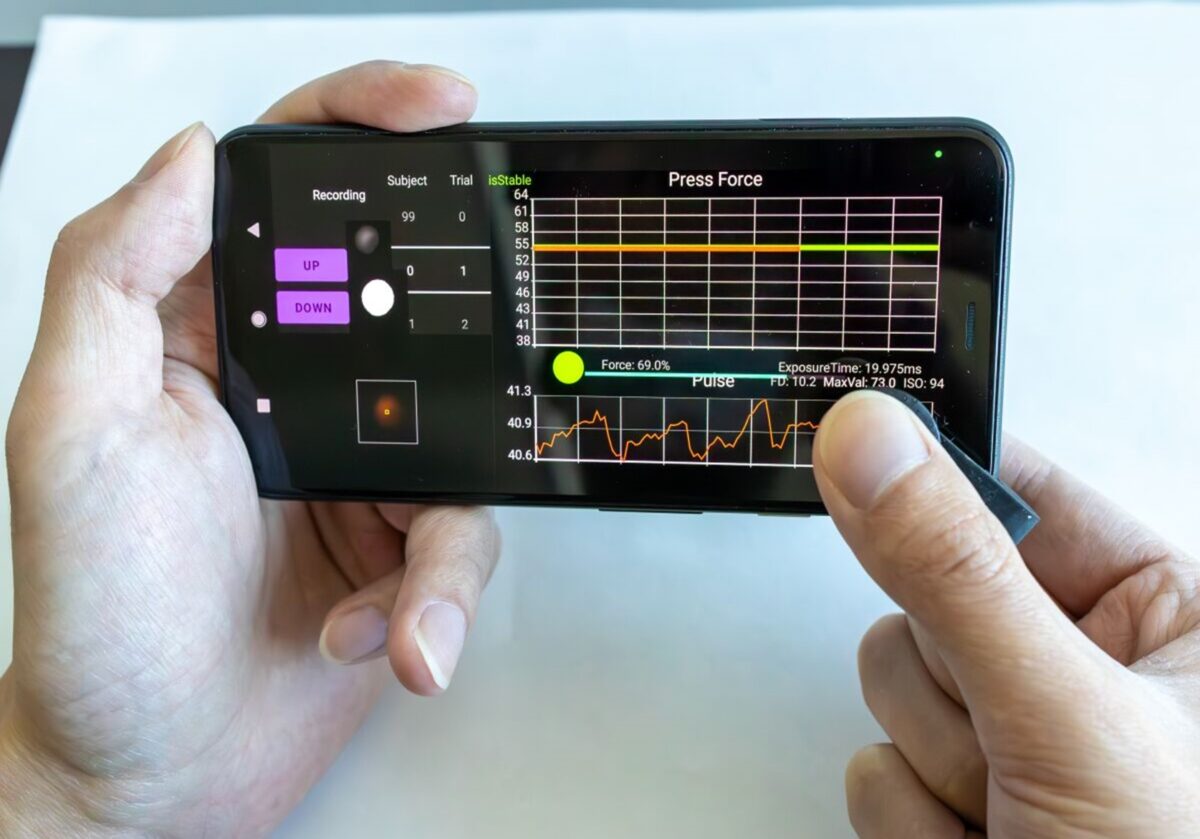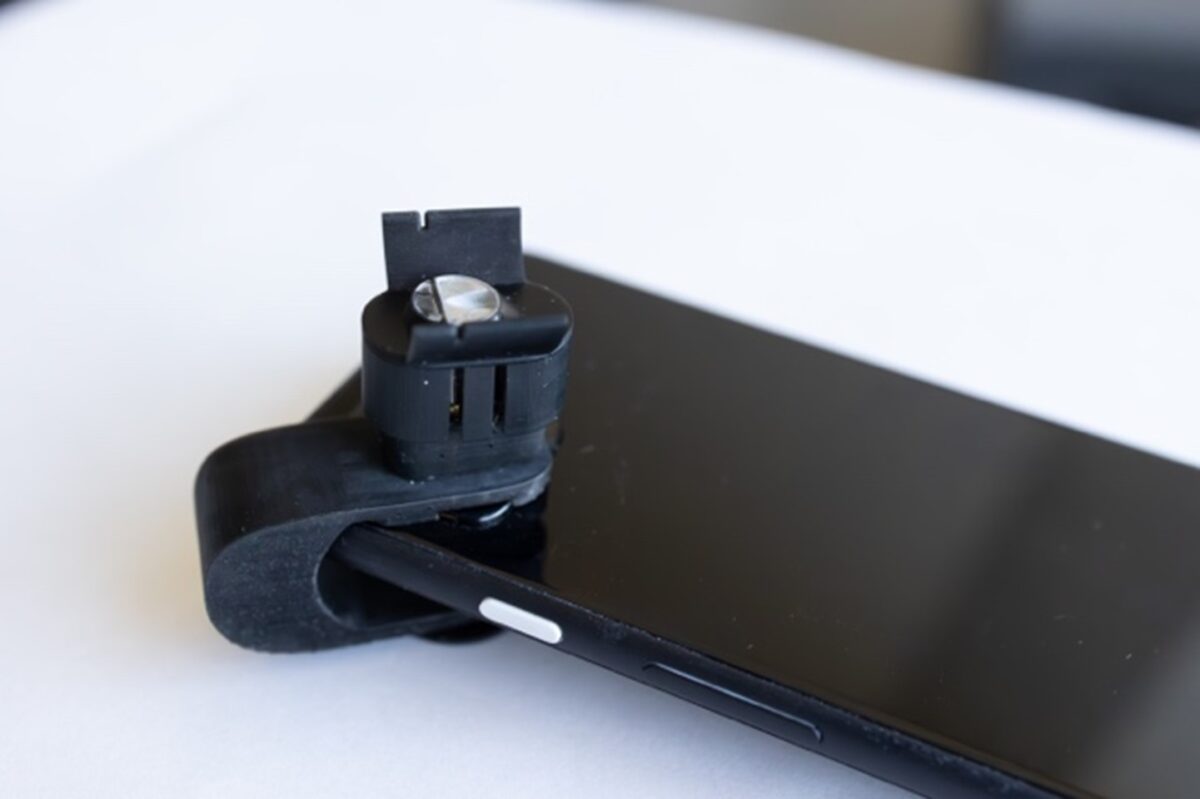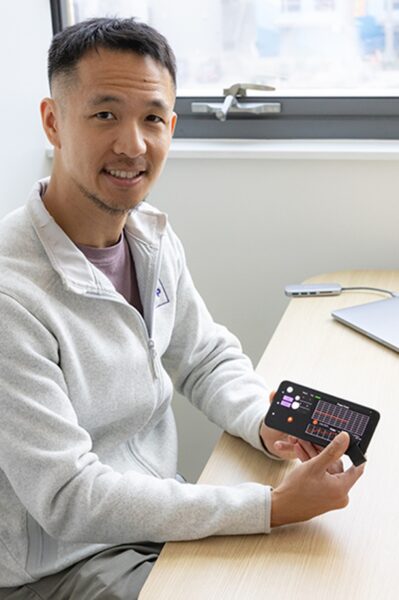Printed Polymer Device Reads Blood Pressure on Smartphone

Polymer device for use with smartphone camera and app delivers low-cost readings
Engineers at the University of California San Diego want to make taking blood pressure a snap.
“We’ve created an inexpensive solution to lower the barrier to blood pressure monitoring,” said Yinan (Tom) Xuan, an electrical and computer engineering PhD student at UCSD who served as first author on a study about their work in Scientific Reports.
The device that Xuan and his colleagues created is a simple plastic clip that attaches to a smartphone and uses the phone’s camera and flash to monitor blood pressure at a user’s fingertip. Dubbed the BPClip, it works with a custom app.

The prototype BPClip attaches to a smartphone and reads blood pressure from a user’s fingertip, which applies pressure to the device. Photos courtesy of UCSD
Designed with SolidWorks CAD software, the BPClip measures 5.1 × 4.1 × 2.3 cm. (2.0 x 1.6 x 0.9 inches) The prototype clamps onto a smartphone using a 3D-printed screw. The clip consists of three main components: base clip, pressing platform and compression spring.
Blood Pressure on Call
“We propose a solution to democratize blood pressure monitoring by converting billions of smartphone cameras, even the cheapest ones, into BP monitors with an ultra-low-cost plastic clip that can be produced at scale for mere cents,” Xuan said. “Our current prototype’s material costs less than $1.00 to manufacture at low quantities. At scale, we expect that a blood pressure monitor will reach an even lower cost.”
To make the prototype, the researchers used an Anycubic Photon Mono X 3D printer to produce the clip with eSUN ABS-Like Hard Tough Resin. eSUN calls this a kind of polyurethane acrylic resin with high levels of hardness, toughness, impact strength, wear resistance and mechanical properties.

UCSD professor Edward J. Wang shows smartphone app that measures blood pressure.
The long-term aim, said Edward J. Wang, is to injection mold the device at scale. Wang is professor of electrical and computer engineering at UCSD and director/founder of its Digital Health Technologies Lab. He also is Xuan’s PhD adviser, a partner in the project and the study’s senior author. Xuan said in an email interview that the team has not decided which resin is most suitable for at-scale production.
“A key aspect of our approach is the ultra-low-cost nature of the design,” the researchers wrote in their study. “Because the mechanism … relies on a spring for force induction and uses a lens-less optical design to pair with the smartphone, the clip only requires … manufacturable mechanical parts. Currently, in small-batch manufacturing of 1,000 units, the material cost of each BPClip system is under $1.00.
“The cost consists of the spring ($0.03), acrylic cover ($0.001), two O-rings ($0.04), anti-slip pads ($0.03), metal rod and tube ($0.15), and the 3D-printable resin ($0.55)—$0.80 in total. Even at low production rates, our proposed system is substantially less expensive than any commercial blood pressure monitor. With most of the cost from 3D-printed plastic, this cost will be substantially lower at scale with injection molding and bulk component costs.”
“Because of their low cost,” Wang wrote in an article posted on the UCSD website, “these clips could be handed out to anyone who needs them but cannot go to a clinic regularly. A blood pressure monitoring clip could be given to you at a checkup.”
Another advantage of the clip is that it does not need to be calibrated to a cuff.
“This is what distinguishes our device from other blood pressure monitors,” said Wang. Other cuffless systems developed for smartwatches and smartphones, he explained, require separate measurements with a cuff.
Credible Pressure Readings
“Our solution is a calibration-free system, meaning you can use our device without touching another blood pressure monitor to get a trustworthy blood pressure reading.”
To measure blood pressure, the user presses on the clip with the fingertip. The custom app guides the user on how hard and long to press during measurement.
When the user presses on the clip, the smartphone’s flash lights up the fingertip. That light is then projected through a pinhole-sized channel to the camera as an image of a red circle. A spring inside the clip allows the user to press with different levels of force. The harder the user presses, the bigger the red circle appears on the camera. (See video demonstration.)
The app extracts two main pieces of information from the red circle. By looking at the size of the circle, the app measures the pressure that the user’s fingertip applies. And by looking at the brightness of the circle, the app measures the volume of blood going in and out of the fingertip. An algorithm converts this information into systolic and diastolic readings.
So far, the team has proven the solution only on a single Android smartphone model, but the design should work equally well on other phone models, said Xuan.
Injection Molding Monitors
Meanwhile, Wang and one of his lab members, Colin Barry, have started a company called Billion Labs Inc. (www.billionlabsinc.com) to commercialize the technology. Barry, a co-author of the paper, is an electrical and computer engineering student at UCSD. He serves as co-founder and chief technology officer of Billion Labs.
Wang said the company’s role will be refining the system to advance it toward injection molding manufacturing, while dealing with necessary regulatory clearances, and developing consumer-level software, which is crucial for end users. Billion will additionally work to make the technology more user friendly, will test its accuracy across different skin tones and develop a universal design.
The UCSD team’s work is supported by MassAITC (a program funded by the National Institute on Aging of the National Institutes of Health, the Altman Clinical and Translational Research Institute Galvanizing Engineering in Medicine (GEM) Awards and a Google Research Scholar Award.
